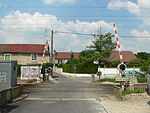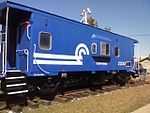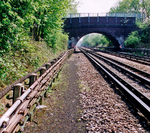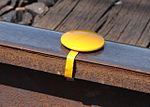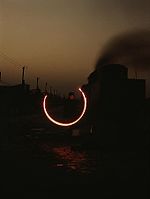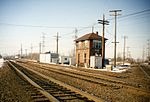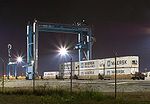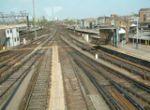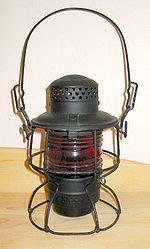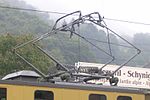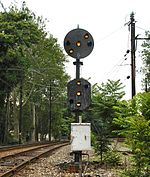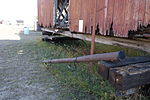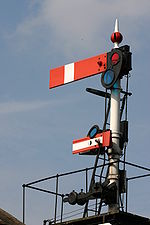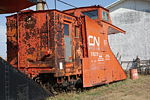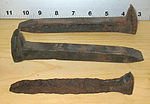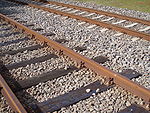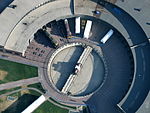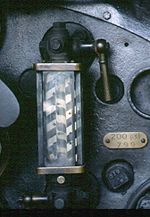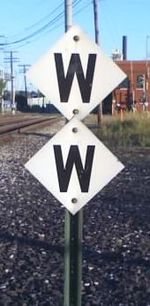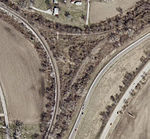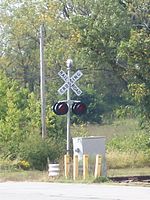- Glossary of rail terminology
-
Rail transport Operations Track Maintenance High-speed Gauge Stations Trains Locomotives Rolling stock Railways History Attractions Terminology By country Accidents
Rail terminology is a form of technical terminology. The difference between the American term railroad and the international term railway (used by the International Union of Railways and English-speaking countries outside the US) is the most obvious difference in rail terminology (see usage of the terms railroad and railway for more information). There are also others, due to the parallel development of rail transport systems in different parts of the world.
Various terms are presented here alphabetically; where a term has multiple names, this is indicated. The note "US" indicates a term peculiar to North America, or "CA" may represent Canada while "UK" refers to terms originating in the British Isles and normally also used in former British colonies outside North America (such as Australia "AU", New Zealand "NZ", etc.). The abbreviation "UIC" refers to standard terms adopted by the International Union of Railways in its official publications and Thesaurus.[1]
Exceptions are noted; terms whose currency is limited to one particular country, region, or railway are also included.
- For terminology specific to the types of lines used for passenger trains, see passenger rail terminology.
- For terminology specific to Australia, see Glossary of Australian railway terminology.
- For terminology specific to the United Kingdom, see Glossary of UK railway terminology.
- For terminology specific to North America, see Glossary of North American railroad terminology.
- For terminology specific to New Zealand, see Glossary of New Zealand railway terminology
Contents: Top · 0–9 · A B C D E F G H I J K L M N O P Q R S T U V W X Y Z 0-9
- Note: for 4-4-0, 2-6-4T, 0-4-4-0, etc. See Whyte notation or UIC classification
Definitions Points of Interest - 10 wheeler or ten wheeler (US): A steam locomotive with a 4-6-0 wheel arrangement.[2]
A
Definitions Points of Interest - Absolute signal: a block signal whose most restrictive indication is stop. An absolute signal is identified by having no number plate or by an A-plate affixed to the mast or supporting structure. Proceeding beyond an absolute signal that is displaying a stop indication is prohibited unless authorized by a dispatcher.
- Air brake: brakes that are operated by compressed air.
- Alco: American Locomotive Company - the second largest builder of steam locomotives in the U.S.[3]
- Alerter: Similar to the Dead man's switch other than it does not require the operator's constant interaction. Instead, an alarm is sounded at a preset interval in which the operator must respond by pressing a button to reset the alarm and timer if no other controls are operated. If the operator does not respond within a preset time, the prime mover is automatically throttled back to idle and the brakes are automatically applied. May also be called a 'Watchdog'.
- All weather adhesion: the maximum adhesion that can be expected of a locomotive in all weather conditions.
- American: A steam locomotive with a 4-4-0 wheel arrangement.[4]
- Angel Seat or Angel's Perch: (US) A term often used when referring to the second level seats on a Cupola style caboose.
- Annett's key (UK), Annett key (AU): A large key which locks levers or other items of signalling apparatus, serving as a portable form of interlocking. With the key removed from the lock, the lever or apparatus is locked in its position. When the key is turned in the lock, it cannot be removed.
- Articulated locomotive: A steam locomotive with one or more engine units that can move relative to the main frame.[3]
- Aspect: (UK) The indication displayed by a colour-light signal e.g. a yellow aspect
- Atlantic: A steam locomotive with a 4-4-2 wheel arrangement.
- A-unit (US): A Diesel locomotive equipped with a full cab and control stand, and hence capable of being the lead unit in a consist. An A-unit that has MU capability is able to control other A-units with MU capability or B-units.
- Auto brake A type of fail-safe system that uses air pressure to hold the brakes off so that in the event the air pressure is lost in the brake pipe the brakes will automatically apply.
- Auto-brake gauge: A gauge recording the application and pressure of an automatic braking system; usually repeated in the guard's van in historic rolling stock.
- Autocoach (UK): A passenger coach fitted with a driving cab and controls for use in an Autotrain (UK).
- Automatic Equipment Identification (AEI) (US): Automatic tracking system using RFID technology.[3]
- Automatic Train Control (ATC)[3]
- Automatic train operation (ATO)
- Automatic train protection (ATP)
- Automatic Warning System (UK): Refers to the specific form of limited cab signalling introduced in 1948 in the United Kingdom to help train drivers observe and obey warning signals.
- Autorack (also called auto carrier) (US): A specialized freight car for transporting automobiles.[3] Car transporter wagon / Car transporter van (UK).
- Autotrain (UK): A branch line train consisting of a steam locomotive and passenger carriages that can be driven from either end by means of rodding to the regulator and an additional vacuum brake valve. The fireman remains with the locomotive and, when the driver is at the other end, the fireman controls the cut off and vacuum ejectors in addition to his usual duties. Also: Push-pull train, Motor train (UK).
- Auto Train (US): A passenger train service first operated by Auto-Train Corporation and then by Amtrak between Lorton, Virginia and Sanford, Florida that carries the passengers' automobiles aboard the same train in autoracks.
- Axle box, see journal box below
 A Cupola style Caboose. Note the Angel Seat above.
A Cupola style Caboose. Note the Angel Seat above.
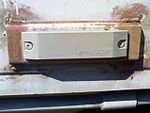 An Automatic Equipment Identification (AEI) Tag attached to a freight car
An Automatic Equipment Identification (AEI) Tag attached to a freight car
 A string of TTX Autorack cars in service
A string of TTX Autorack cars in service
Contents: Top · 0–9 · A B C D E F G H I J K L M N O P Q R S T U V W X Y Z B
Definitions Points of Interest - B unit (US): A cabless booster locomotive, controlled via MU from a cab-equipped A unit. Sometimes equipped with limited controls for hostling.[5][6][7]
- Bacon slicer (UK): Slang term for a cutoff controlled by a wheel operating through a worm and nut, rather than the more usual quadrant lever. The device was slow to operate, but very precise, and therefore only fitted to long-distance locomotives where frequent changes of cut-off were not required.
- Bad order: A tag or note applied to a defective piece of equipment. Generally, equipment tagged as bad order is not to be used until repairs are performed and the equipment is inspected and approved for use.[8]
- Baldwin: American locomotive manufacturer.[8]
- Ballast: aggregate stone, gravel or cinders forming the track bed on which sleepers (ties) and track are laid to ensure stability and proper drainage.[8]
- Balloon: A looped length of track, usually at the end of a spur or branch, which allows trains to turn around for the return trip without reversing or shunting. Can be used as part of a freight installation to allow the loading or unloading of bulk materials without the need to stop the train (see merry-go-round train (MGR)).
- Bank: A particularly steep section of line that requires additional bank (or banking) engines (US: helper engines) to help trains climb.
- Base plate (UK), tie plate (US): An iron or steel plate used to spread the weight of rail over a larger area of sleeper (tie) and facilitate a secure, low maintenance, fastening with bolts or clips. It derives from the former rail chairs.
- Bay platform: A type of platform/track arrangement where the train pulls into a siding, or dead-end, when serving the platform.
- Beep: A one-of-a-kind switcher locomotive (also referred to as the SWBLW) built by the Atchison, Topeka and Santa Fe Railway in 1970.
- Berkshire: A steam locomotive with a 2-8-4 wheel arrangement.
- Blastpipe: A part of a steam locomotive that discharges exhaust steam from the cylinders into the smokebox beneath the chimney in order to increase the draught through the fire.
- Blower: On a steam locomotive, a steam pipe leading into the smokebox, causing necessary draft in the chimney (stack) when the engine is not running. However, UK practice is to turn on the blower also when entering tunnels, etc., to avoid dangerous blow-back into the cab. (The UK loading gauge is much smaller than that in the US and the tunnel roof would otherwise spoil the normal draft created from the exhaust.) On a two-stroke diesel engine, the blower is a mechanical device that scavenges the cylinders: not to be confused with a supercharger.
- Bobber: (archaic, US): A slang word for a small caboose with just four wheels, all rigidly mounted to the frame. This design was common in the 19th century. Bobber refers to the bouncing action of such a caboose while in motion.
- Bo-Bo (Europe): A locomotive with a 4 wheel per truck configuration, each individually powered, as opposed to a 6-wheel "Co-Co" configuration.
- Bogie: (chiefly UK) The undercarriage assembly incorporating the wheels, suspension, brakes and, in powered units, the traction motors. Generally called a truck in the US.
- Boiler: A cylindrical container adjacent to the firebox in which steam is produced to drive a steam locomotive.[9]
- Bonds: Short wires used to bridge gaps in electrical circuits, usually at track circuit joints or between rails.
- Booking Clerk: A person at a station whose job is specifically selling tickets.
- Boom barrier: A barrier at a level (rail) crossings.
- Booster: (Steam locomotive) - An extra set of cylinders that can be engaged to drive a trailing truck or tender truck to give additional tractive effort at starting and low speeds.[8]
- Boxcar (US): a type of rolling stock with a flat bottom enclosed on all sides and top, which is loaded and unloaded from sliding doors on each side.[8] Same as van (UK).
- Brakeman (US): A train crew member who performs railcar and track management; often a single job description along with switchman ("brakeman/switchman"). A brakeman manually activated brakes on railroad cars before the advent of air brakes.
- Brakeman's cabin, brakeman's cab or brakeman's caboose (US): small hut at one end of a railway wagon to protect the brakeman from the elements.
- Brake Pipe (US): The main air pipe of the trains pneumatic braking system.
- Brake van (UK): A heavy vehicle with powerful brakes which was attached to the rear of goods trains in the days when most wagons were not fitted with a continuous braking system. Its function was to supplement the locomotive's braking power in slowing and stopping the train and to keep the couplings uniformly tight by selective light braking to avoid snatching and breakages. It also conveyed the train guard, hence its alternative name of "guards van". Partly analogous to caboose and its synonyms.
- Branch line: A secondary railway line that branches off a main line.[8]
- Broad gauge: Track where the rails are spaced more widely apart than 1,435 mm (4 ft 8 1⁄2 in) (which is called standard gauge).[8] Many early railroads were broad gauge, for example the Great Western Railway in the UK which adopted 7 ft 1/4 in (2141 mm) gauge until it was converted to standard gauge in the 1860s - 1890s. Russia still has over 80,000 km of broad gauge (1520 mm or 5 ft) railroads. Broad gauge is also normal in Spain, Portugal, and India (1680 mm or 5 ft 6 ins), as well as Ireland and used in some parts of Australia (1600 mm or 5 ft 3 ins).
- BRUTE: British Rail Universal Trolley Equipment - type of platform trolley found on stations all over the UK rail network from the late 1960s to the early 1980s.
- Bubble Car: A DMU consisting of a single coach (UK), e.g. British Rail Class 121
- Buckeye coupler: A form of coupler which will lock automatically when the two parts are pushed together.
- Buck (US): A term used for pushing railroad cars with a locomotive then allowing them to roll under their own momentum into a siding. (Assuming a brakeman hangs on for a free ride) Also; Kick.
- Buffer A device that cushions the impact of rail vehicles against each other.
- Buffer stop: The barrier installed at the end of a dead end track to prevent rail vehicles from proceeding further.
- Bull head rail (UK): A steel rail section commonly used in 60 ft lengths on almost all railway lines throughout Britain until c1950, which due to its shape must be supported in cast iron chairs that are screwed to the sleepers. It is still found on secondary and preserved lines and in yards. The rail has two heads (shaped somewhat like a vertical dumbbell) so, when one side became worn, the rail could be inverted and reinstalled for further service rather than being replaced.
- Bustitution: The practice of replacing train service, whether light rail, tram/streetcar systems, or full-size railway systems, with a bus service, either on a temporary or permanent basis. Somewhat derogatory and mainly used in the UK, Canada, USA, and Australia. The word is a portmanteau of the words "bus" and "substitution".
 An example of a BNSF Railway bad order repair tag
An example of a BNSF Railway bad order repair tag
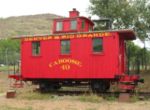 A "Bobber" 4-wheel caboose of the Denver & Rio Grande Railroad preserved at the Colorado Railroad Museum, Golden, Colorado
A "Bobber" 4-wheel caboose of the Denver & Rio Grande Railroad preserved at the Colorado Railroad Museum, Golden, Colorado
Contents: Top · 0–9 · A B C D E F G H I J K L M N O P Q R S T U V W X Y Z C
Definitions Points of Interest - Cab forward: Typically refers to a steam locomotive that is "turned around" so that its cab is at the leading end and its tender is connected to the smokebox end. The most famous example is the Southern Pacific Railroad's AC type, built to handle drag freights through the SP's many tunnels and snowsheds without the danger of the exhaust asphyxiating the engine crew.
- Cabin car (PRR): See caboose.[10]
- Cabless: A locomotive without a cab. Commonly referred to as a B unit or a Slug. Although not all Slugs are cabless.
- Caboose: A railroad car attached usually to the end of a train, in which railroad workers could ride and monitor track and rolling stock conditions. Partly analogous to brake van (UK). Largely obsolete, having been replaced by the electronic End of Train (EOT) device, or Flashing Rear End Device called "FRED".[10]
- Cant: Angle. Can be used in the context of the cant of the track (the relative level one rail to another, e.g. on curves) (UK); and the cant of a rail, being the angle of an individual rail relative to vertical.
- cape (UK): To note the cancellation of a passenger train service to employees. (From British Railways telegraphic codeword[11])
- Carbody unit or cab unit (US): A locomotive which derives its structural strength from a bridge-truss design framework in the sides and roof, which cover the full width of the locomotive. It refers to both A units and B units.
- Carman (US): A mechanic responsible for maintaining and inspecting the rolling stock.
- Catenary or catenary structure: The overhead wire system used to send electricity to an electric locomotive or multiple unit, tram or light rail vehicle.[10]
- Centralized traffic control (CTC) (US, AU): A system in which signals and switches for a given area of track are controlled from a centralized location. May or may not be computerized.[10]
- Cess (UK): The area either side of the railway immediately off the ballast shoulder. This usually provides a safe area for workers to stand when trains approach.
- Chair (UK): A cast iron bracket screwed to the sleeper and used to support bull head rail that is held in place by a wooden key (wedge) or spring steel clip. Still found on preserved railways and in yards.
- Challenger: A steam locomotive with a 4-6-6-4 wheel arrangement.
- Ches-C (US): Chessie System's kitten logo.[12][13]
- Chimney (UK): Smokestack or stack (US), or funnel.
- Co-Co (EU): A heavier duty locomotive with 6 wheels per bogie (all axles being separately driven) configuration as opposed to a 4-wheel "Bo-Bo" configuration. The correct classification is Co'Co', but Co-Co is used more often.
- COFC: Abbreviation for "Container On Flat Car".[10]
- Colour light signal: A signal in which the colour of the light(s) determine the meaning of the aspect shown.
- Colour position signal: A signaling system that uses both colour and light position to determine the meaning of the aspect shown.
- Combined Power Handle: A handle or lever which controls both the throttle and the dynamic braking on the locomotive: forward (away from operator) past center is throttle up, backward (toward operator), past center, operates the dynamic brake.
- Composite (UK passenger car): A passenger car with more than one class of accommodation provided, e.g. First and Third. In earlier days of three-class travel, First and Second class, and Second and Third class composites were also built. A car with First, Second and Third classes was also known as a tri-composite.
- Compound locomotive: A steam locomotive passing steam through two sets of cylinders. One set uses high pressure steam, then passes the low pressure exhausted steam to the second.[14]
- Compromise joint: A special joint bar used to join rail ends of two different cross-sections while holding the top running surface and inside gauge surface even.
- Conductor (US), guard (UK): The person "in charge" of a train and its crew. On passenger trains, a conductor is also responsible for tasks such as assisting passengers and collecting tickets. In Australia, both terms are used, "conductor" for the person checking tickets, etc. on a tram or train, and "guard" for the person in charge of the train.
- Consist (US), formation (UK): A noun to describe the group of rail vehicles making up a train, or more commonly a group of locomotives connected together for Multiple-Unit (MU) operation.[10]
- Consolidation: A steam locomotive with a 2-8-0 wheel arrangement.
- Continuous welded rail (CWR): In this form of track, the rails are welded together by utilising the thermite reaction or flash butt welding to form one continuous rail that may be several kilometres long.[10]
- Control car or Cab car: A passenger coach which has a full set of train controls at one end, allowing for the use of push-pull train operation.
- Control Point (CP) (US): An interlocking, or the location of a track signal or other marker with which dispatchers can specify when controlling trains.[10]
- Cornfield meet (US): A head-on collision between two trains.[15][16][17]
- Coupler (US), coupling(UK): Railroad cars in a train are connected by couplers located at the ends of the cars.[10]
- Coupling rods or connecting rods: Rods between crank pins on the wheels, transferring power from a driving axle to a driven axle of a locomotive.[18]
- Cow and calf: A diesel locomotive with a crew cab permanently coupled to and acting as a controller for a similar slave diesel locomotive without a crew cab, primarily used for switching/shunting duties for large groups of rolling stock. Also known as master and slave, as in the British Rail Class 13 shunters at Tinsley Marshalling Yard.
- Cowl unit (US): A locomotive whose sides and roof are non-structural, and cover the full width of the locomotive. Structural strength comes from the underframe.
- Crank pin: A pin protruding from a wheel into a main or coupling rod.
- Crew driver (US): Person(s) operating ground transportation vehicles for transporting railroad crews to and from various locations.
- Crosshead: The pivot between the piston rod and the main rod on a steam locomotive.[19]
- Cross-tie (U.S): sleeper (UK): See Railroad tie.
- Cut off: A variable device on steam locomotives which closes the steam valve to the steam cylinder before the end of the piston stroke, thus conserving steam while allowing the steam in the cylinder to expand under its own energy. Also: Reverser.
- Cutting: A channel dug through a hillside to enable rail track to maintain a shallow gradient. See also embankment
- Cylinder: The central working part of a reciprocating engine, the space in which a piston travels.
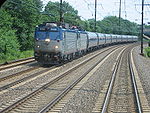 An electric Amtrak train with two AEM-7 locomotives running through New Jersey on the Northeast Corridor. The catenary system is clearly visible.
An electric Amtrak train with two AEM-7 locomotives running through New Jersey on the Northeast Corridor. The catenary system is clearly visible.
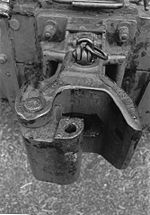 An AAR Type "E" railroad car coupler (US)
An AAR Type "E" railroad car coupler (US)
Contents: Top · 0–9 · A B C D E F G H I J K L M N O P Q R S T U V W X Y Z D
Definitions Points of Interest - Dark Signal: A block signal that is displaying no discernible aspect, often due to burned out lamps or local power failure. Most railroads require that a dark signal be treated as displaying its most restrictive aspect, e.g., stop and stay for an absolute signal.
- Dark territory: A section of track without block signals.[20]
- Dead man's handle or Dead man's switch: A safety mechanism on a train controller which automatically applies the brake if a lever is released. It is intended to stop a train if the driver is incapacitated. In some forms, this device may be pedal-actuated.
See also: Dead-man's vigilance device
- Deadhead: (US) 1. A nonrevenue (i.e., nonpaying) passenger. 2. The nonrevenue movement of locomotives and/or cars.
- Decapod: A steam locomotive with a 2-10-0 wheel arrangement.
- Defect detector: A track side device used to detect various defects such as hotboxes (overheated axle bearings), dragging equipment, leaning cars, overloaded cars, overheight cars, seized (locked) wheels, etc.[21]
- Demurrage: A monetary charge levied by a railroad to a customer for excessive delay in loading or unloading cars.
- Derailer, a safety device that will derail vehicles passing it, often used to prevent rolling stock from unintentionally fouling the mainline.[21]
- Detonator: Small explosive charges placed on the running rail which detonate when run over; used to warn drivers in following trains of an incident ahead. Also called track torpedoes (US).
- Diamond: Trackage which allows a rail line to cross another at grade.[21]
- Diesel multiple unit or DMU: A set of diesel-powered self-propelling passenger rail vehicles able to operate in multiple with other such sets. Such units, especially those consisting of a single vehicle, are sometimes termed railcars.
- Direct Traffic Control (DTC): A system in which train dispatchers communicate directly with train crews via radio to authorize track occupancy in predefined blocks.[21]
- Distributed power: A practice employed to move large trains through the mountains. Consists of the locomotives on the head end, a "swing" (mid-train) helper or two, and pusher locomotive(s) on the rear; today, all units are remotely controlled by the engineer in the lead unit. The power distribution alleviates stress on the couplers and relieves the lead units of the full weight of the train, making it easier to move on grades.
- Ditch lights: A pair of lights, usually found on modern locomotives, located several feet below and outboard of the main headlight, that may alternately flash when the train is sounding its horn.
- DOO: Driver-only operation, also referred to as One person train operation (OPTO).
- Doodlebug: Gasoline-electric self-powered passenger car used for small capacity rural commuter service.[21] Also a British Rail Class 153 DMU.
- Double, as in "Double the hill": if a train has insufficient power to climb a grade and no helpers are available, the train will be split into two sections and run separately to the top.[22]
- Doubleheading or Doubleheader (US): In which two steam locomotives are coupled head-to-tail in order to haul a heavy train up a long and/or steep hill. In the present day, doubleheaders (and occasionally tripleheaders) are done primarily on large passenger trains or as a show for railfans.
- Down: (UK) A direction (usually away from London, other capital city, or the headquarters of the railway concerned) or side (on left-running railways, the left side when facing in the down direction). The opposite of up. The down direction is usually associated with odd-numbered trains and signals. In Australia it is used relative to the state's capital city. US railways use the compass points northbound, southbound, eastbound and westbound.
- Dragging equipment detector: See Defect detector[21]
- Drift: Cutting off power and allowing a train to coast.
- Driver (UK), Engineer (US): The operator of a railway/railroad locomotive.
- Driver: A wheel in contact with the rail that also propels a locomotive.
- Driving Van Trailer or DVT (UK): A class of control cars used in the UK. (See also: DBSO - predecessor to the DVT)
. 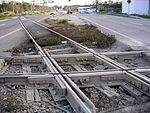 Railroad crossing at grade, also known as a diamond. This example is located in Mulberry, Florida.
Railroad crossing at grade, also known as a diamond. This example is located in Mulberry, Florida.
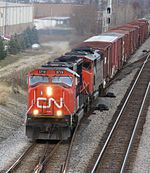 A Canadian National Railway train showing the placement of ditch lights on the locomotive.
A Canadian National Railway train showing the placement of ditch lights on the locomotive. A DMU in Poland
A DMU in Poland
Contents: Top · 0–9 · A B C D E F G H I J K L M N O P Q R S T U V W X Y Z E
Definitions Points of Interest - ECS: Empty coaching stock. Describes a passenger train which is not in service. For example, it may be being moved from a depot to a terminal station.
- Ejector: Component of vacuum brake system. Steam passing through a cone sucks air from the train pipe to create the vacuum. Usually fitted in pairs: a small ejector running continuously to overcome leaks and to restore the vacuum after light braking and a large ejector operated when needed to release the brakes quickly after a heavy application or to create the initial vacuum ("making a brake" – UK) after coupling up.
- Electric multiple unit (EMU): A set of electrically powered self-propelling passenger rail vehicles able to operate in multiple with other such sets.
- Elephant style (US) - Railfan jargon to describe how multiple locomotives are coupled together in a train; the front of the second locomotive is coupled to the rear of the first locomotive, the front of the third locomotive is coupled to the rear of the second locomotive, and so on down the line.[23] The term is reminiscent of a parade of circus elephants where the elephant behind the front elephant would hold the leading elephant's tail in its trunk.
- Elevated railway: One typically built on supports over city streets, commonly called "the el" or simply the "The L".
- Embankment: A raised pathway on which rail tracks are placed to maintain a shallow gradient when passing over depressions in the terrain. See also cutting.
- Empty Coaching Stock train, or ECS: A train used to bring carriages into (or out of) service. They usually run between sidings and main stations, with the carriages then forming a service train to another destination. They are often worked under freight train rules - e.g. without needing a guard in the UK.
- EMD: Electro-Motive Diesel, Inc, the world's second largest builder of railroad locomotives. EMD was previously Electro-Motive Division of GM before being sold.
- Engineer (US), driver, engine driver, train driver (UK): The operator of a locomotive.[24]
- EOT (US): End of train device. A form of an electronic caboose also called FRED.[24]
- EP gauge (UK): Electro-pneumatic brake gauge; recording the application and pressure of the service brake, usually repeated in the guards van in historical rolling stock.
- Event recorder - A device that continuously captures analog and digital train systems information and stores that data for a minimum of 48 hours. This data is used to evaluate incidents and accidents. Typical stored data includes speed, brake pressure, dynamic brake, horn activation, track signal, etc. In the U.S., event recorders are mandated by the Federal Railroad Administration (FRA) for freight, passenger and commuter rail. Regulations for railroad outside the U.S. vary by country. Transit operations are not generally required to have event recorders, but have begun to add them voluntarily.
- Ex-con (US): An ex-Conrail locomotive (jargon) or former employee of Conrail. Not to be confused with the more common meaning of a convicted criminal who has been released after serving prison time.
- Express train: A train that passes selected stations without stopping.
- Extra train: A train that is not included in the normal schedule of a railroad. In train order territory, extras are required to clear the main line for scheduled trains to pass.
 Three BN locomotives coupled elephant style"
Three BN locomotives coupled elephant style"
Contents: Top · 0–9 · A B C D E F G H I J K L M N O P Q R S T U V W X Y Z F
Definitions Points of Interest - Facing: A turnout is facing if it can select which way to diverge a train. Opposite of trailing.
- Fairlie: A type of articulated locomotive, typically (but not exclusively) with two boilers and connected fireboxes in a central cab.
- Fall plate: A heavy, hinged steel plate attached in a horizontal position to the rear of the locomotive footplate or front of a locomotive tender. When the tender is attached to its locomotive the plate is allowed to fall to cover the gap in the "floor" between the two units. The sliding edge is not fixed and has a smooth chamfer so as to avoid a trip hazard.
- Fallen flag (US): A railroad which is defunct, having either merged or discontinued operations.[25]
- Feedwater heater: A device to preheat the water for a steam locomotive; improves efficiency.
- Fettle, fettling: Making repairs to rail track, especially concerned with maintaining the drainage of the ballast, and the proper cant of the rail track and rails.
- Fiddle Yard: A concealed group of sidings used in model railways to provide more realistic operation in limited space.
- Firebox: In steam railroading, a firebox was a chamber in which a fire would produce sufficient heat to create steam once the hot gases from the firebox were carried into the adjacent boiler via tubes or flues.[26]
- Fireman (also Stoker, Boilerman): A worker whose primary job is to shovel coal into the firebox and ensure that the boiler maintains sufficient steam pressure; a driver's assistant.
- Fishplate (UK), Joint bar (US): A metal plate that joins the ends of rails in jointed track.
- Flat: A wheel defect where the tread of a wheel has a flat spot and is no longer round; flats can be heard as regular clicking or banging noises when the wheel passes by. This is caused either by a locked bearing, or a brake that was not fully released before the car was moved, dragging the wheel without turning.[27]
- Flatcar (US): A type of rolling stock, which can be a flat-bottomed car with no sides on which freight (including intermodal containers) can be stacked. A bulkhead is a flatcar with walls on the front and rear. A center-beam bulkhead is a bulkhead flatcar with an additional wall dividing one side of the flatcar from the other, but still without any sides.[27] Flat wagon (UK).
- Flying junction, Flyover: A railway junction that has a track configuration in which merging or crossing railroad lines provide track connections with each other without requiring trains to cross over in front of opposing traffic.[27]
- Foamer (US): A colloquial term for a railfan, specifically one whose enthusiasm is excessive, "foaming at the mouth".[28]
- Fouling point: The point near a switch where a car or locomotive on one track will obstruct movement on the adjacent track.
- Four-foot: The part of the line between a pair of running rails. An abbreviation for four foot, eight-and-a-half-inches. Also see six-foot and ten-foot.
- Four-quadrant gate: A type of Boom barrier, see above.
- FRA: (US) The Federal Railroad Administration. This agency oversees rail operation regulations and safety requirements for U.S. freight, passenger and commuter rail operations.[27]
- Flashing Rear-End Device (FRED) (US): A small marking device with a flashing red light mounted on the end of the train. FRED also monitors various train functions such as brake pipe pressure, motion and GPS location. A form of an electronic caboose. Also called an EOT (end of train) device.[27][29]
- Free-mo: A type of modular layout in model railroading.
- Freight (US) Goods (UK): the product(s) in which are carried.
- Frog: (US) A casting with "X" shaped grooves used in switches and crossovers.[27]
- Funnel: A Thomas the Tank Engine misnomer for a chimney] (UK) or smokestack (US), although it is also used in Australia (Victoria at least). Some early steam engines had a smokestack consisting of a straight vertical flue and a funnel-shaped top, probably leading to the use of "funnel" to describe the entire stack.
- Fusee: A pyrotechnic device similar to an automotive flare that is used for signalling.[27]
- Fusible plug: A threaded plug, with a soft metal core, that is screwed into the crown plate of a firebox. If the water level gets too low the core melts and the noise of the escaping steam warns the enginemen.
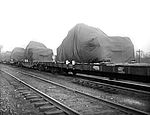 A train of loaded flatcars
A train of loaded flatcars
 Four-quadrant gates at Chertsey, England. The gates are rising.
Four-quadrant gates at Chertsey, England. The gates are rising.
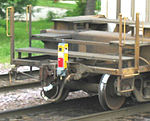 A FRED — Flashing Rear-End Device
A FRED — Flashing Rear-End Device
Contents: Top · 0–9 · A B C D E F G H I J K L M N O P Q R S T U V W X Y Z G
Definitions Points of Interest - Gage: An alternate (US) spelling of "Gauge" as in "track or rail gage".
- Gandy dancer (slang, US): A track maintenance worker.[30]
- Garratt: A type of articulated locomotive.
- Gauge: The width between the inner faces of the rails.
- Geep: A slang term for any of the GP ("general-purpose") series of Electro-Motive four-axle diesel locomotives; originally applied only to EMD GP7, GP9, and GP18 models.[30]
- Glad hand A quick-coupling/uncoupling connector at the end of a trainline air hose that resembles a pair of "shaking hands" when hoses are connected.
- Go-devil: A hand-powered railroad car (see Handcar and Draisine ), or a small gasoline powered railroad car .
- Gondola: A type of rolling stock with a flat bottom and relatively low sides, used to haul material such as ore or scrap, and loaded and unloaded from the top. May be covered or uncovered. Open wagon (UK).[30]
- Goods (UK): Freight (US): Both terms are used in Australian English
- Goods wagon or Goods van or Goods truck (UK): Freight car or Box car (US): A flat car with sides and a top, usually with a large sliding door in the middle of each side.
- Go to beans (slang, US): Train crew parlance for stopping to take a coffee or meal break during a shift.
- Grab bar: A handle on the side of a car to allow switching personnel to hold on (also known as a "grab iron").
- Green: A colour associated with go or proceed.
- Guard (UK): Conductor (US) See Conductor above.
- Guard rail (US) Check rail (UK): A double rail section of track, sometimes found in train yards and on bridges to prevent derailments or limit damage caused by derailments, by having rail on both sides of the wheel flange. Also found on curves with a tight radius and switches and crossings[30]
- Gunzel (AU) Railway enthusiast. In Melbourne, Victoria it often refers to tramway enthusiast.
 A Garratt locomotive
A Garratt locomotive
 An EMD GP38-2, "General Purpose" (GP) locomotives are often called a "Geep"
An EMD GP38-2, "General Purpose" (GP) locomotives are often called a "Geep"
 A Gondola type of railroad car
A Gondola type of railroad car
Contents: Top · 0–9 · A B C D E F G H I J K L M N O P Q R S T U V W X Y Z H
Definitions Points of Interest - Hack (slang, US): A caboose, since it carried the crew around like a taxicab.
- Hammerhead style (slang, US): The practice of running a Diesel locomotive with its long hood forward. This has been done for a variety of reasons, such as crew safety in case of a collision. On short runs, operating the locomotive "backwards" is more economical than using a wye or turntable or operating a second locomotive. Some locomotives may have a second control stand to facilitate operation in the "reverse" direction.
- Handcar(US), A small, hand-powered railroad car used for track inspection. Pump trolley (UK).
- Head end power or HEP: A scheme whereby the locomotive engine or a separate generator provides 'hotel' power to carriages.[31]
- Headboard. A sign attached to a locomotive to identify a named train or tour/charter, or for other special occasions.[32]
- Headshunt (UK), Shunting neck (US): A length of track feeding a number of sidings that permits the sidings to be shunted without blocking the main line, or where two lines merge into one before ending with a buffer, to allow a run-round procedure to take place.[33]
- Heavy haul: Heavy freight operations.
- Heavy rail (US): A city-based transit rail system that runs on its own dedicated track and often underground. Subways are considered heavy rail. Refers to commuter rail and inter-city rail when used by the FRA or in other countries.
- Heavyweight (US): During the period between about 1910 and the mid nineteen thirties, most passenger cars in the US were built with three axle trucks, concrete floors, and riveted, double walled sides and often weighed 90 - 100 tons or more. Heavyweight construction was used to improve ride quality.[31][34]
- Highball (US): 1. The conductor's signal for a train to depart. 2. To move at speed over the main track on a clear signal indication. Originated with the now-obsolete ball signal system, in which a ball hoisted all the way to the top of its post indicated to a train crew that the track ahead was clear.[31]
- High Iron (slang): The mainline track.
- High rail: The upper rail in a curve or superelevation which typically experiences the higher lateral loads and greater wear.
- Hit the ground (slang): To derail
- Hogger (slang, US): A locomotive engineer.[31][35][36]
- Hole, the: A passing siding. Inferior trains "lay over in the hole" to let superior ones pass.
- Hoodlebug (slang, US): A small commuter passenger train or trolley.
- Hood unit (US): A locomotive whose sides and roof are nonstructural and do not extend the full width of the locomotive. Structural strength comes from the underframe.[31]
- Horn blocks: Plates lining the axlebox cut-outs in a locomotive frame to allow smooth vertical movement under control of the springs.
- Hotbox: An axle bearing that has become excessively hot due to friction.[31][37][38]
- Hotbox detector: A device attached to the track which monitors passing trains for hot axles, and then reports the results via a radio transmission (US) or a circuit to the signal box (UK). (see defect detector).[31]
- Hotel power (US): Electric power used to provide for the comfort of passengers aboard a train en-route. See "HEP" above.
- Hot rail (US): 1. Any section of track over which a train movement is imminent. The closer and/or faster the approaching train, the "hotter" the rail. 2. On some electrified railroads and rapid transit lines, the third rail which supplies power to locomotives or cars.
- Hotshot (US): A fast, long-distance train given priority on the track over other trains.
- Hudson: A steam locomotive with a 4-6-4 wheel arrangement.
- Hump: A raised section in a rail sorting yard that allows operators to use gravity to move freight railcars into the proper position within the yard when making up trains of cars (that is, humping the cars). This is faster and requires less effort than moving cars with a switching engine.[31]
- Hunting: Swaying motion of a railway vehicle or bogie caused by the coning action on which the directional stability of an adhesion railway depends. The truck or bogie wanders from side to side between the rails, "hunting" for the optimum location based on the forces at play.[31]
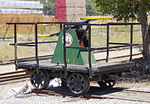 A handcar (pump trolley UK)
A handcar (pump trolley UK)
Contents: Top · 0–9 · A B C D E F G H I J K L M N O P Q R S T U V W X Y Z I
Definitions Points of Interest - Infill station (sometimes in-fill station): A train station built on an existing passenger line to address demand in a location between existing stations.
- Injector: A device to force water into a steam locomotive's boiler by steam pressure.[39]
- Interlocking (US): Any location that includes a switch or crossing of two tracks, derived from the early practice of installation of a system of mechanical equipment called an interlocking plant to prevent collisions. See also signal box. Interlocking is also the term for the actual mechanical or electrical apparatus that prevents switch/points and signals from being operated in ways that would allow for conflicting train movements.[39]
- Intermodal: Moving goods or people by more than one type of vehicle. Intermodal freight can be transported using shipping containers which can easily be transferred among railroad flatcars, ships, airplanes, and tractor-trailer trucks.[39]
- IRJ, IBJ: Insulated rail joint/insulated block joint. Rail joints incorporating insulation to isolate individual track circuits.
- Island platform: A railway platform that has tracks along the full lengths of both sides.
Contents: Top · 0–9 · A B C D E F G H I J K L M N O P Q R S T U V W X Y Z J
Definitions Points of Interest - Jack: A dwarf signal (slang, Boston and Maine and New York New Haven and Hartford Railroads)
- Jerk a lung (North America): To break a train in two, usually by shearing the knuckle pin in a coupler, often caused by the application of excessive head end power at startup. Example: "The engineer jerked a lung on the upgrade."
- Johnson bar (US): On a locomotive, a long, heavy lever that operates the cutoff, etymology unknown.[40]
- Joint bar, fishplate (UK): Joins the ends of rails in jointed track. Also referred to in North America as a rail joiner or angle bar.[41]
- Jointed track: Track in which the rails are laid in lengths of around 20 m and bolted to each other end-to-end by means of fishplates (UK) or joint bars (US).[40]
- Journal bearing: a bearing without rolling-elements; a plain bearing
- Journal box, the housing of a journal bearing.[42]
- Junction: A point at which two lines or separate routes diverge from each other.[40]
Contents: Top · 0–9 · A B C D E F G H I J K L M N O P Q R S T U V W X Y Z K
Definitions Points of Interest - KE: (Kinematic Envelope) The outline of the space beside and above the track that must be kept clear of obstructions for the train to pass. This can be larger than the static clearance around an unmoving engine or car.
- Key (UK): Timber or sprung steel block used to secure Bullhead rail into the chairs.
Contents: Top · 0–9 · A B C D E F G H I J K L M N O P Q R S T U V W X Y Z L
Definitions Points of Interest - Lantern (US) Lamp (UK/AU): A portable (often handheld) light source that is used to signal train crews.
- Leaner (US): (slang) A car in which the load has shifted, or it has been improperly loaded, or a mechanical failure has occurred that causes the car to lean to one side. This could potentially cause a collision or derailment.
- Level crossing: a crossing on one level ("at-grade intersection") — without recourse to a bridge or tunnel — generally of a railway line by a road or path (also called a railroad crossing, railway crossing, train crossing or grade crossing (US)). The term is sometimes used for a crossing by (not a junction with) another rail track (known as a flat crossing in the UK).
- Level junction (US), Flat junction (UK): A junction in which all track crossings take place at grade and routings must therefore be controlled by signals and interlocking.
- Light engine: A locomotive travelling on its own, or perhaps with just a caboose (brake van) attached.[43]
- Light rail: A city-based rail system based on tram design standards that operates mostly in private rights-of-way separated from other traffic but sometimes, if necessary, mixed with other traffic in city streets.[44] Light rail vehicles (LRV) generally have a top speed of around 55 mph (89 km/h) though mostly operating at much lower speeds, more akin to road vehicles. Light rail vehicles usually run on trackage that weighs less per foot (due to a smaller track profile) than the tracks used for main-line freight trains; thus they are "light rail" due to the smaller rails usually used.[43]
- Local train: A train that stops at most, if not all, stations along its route. Often referred to in North America as a "milk train" or "milk run" (usage from the days when trains stopped at every station and stop along their route to pick up fresh milk brought to the stations daily from local dairy farms).
- Location case (UK): A trackside cabinet used to house signalling equipment such as relays or transformers.
- Loop (UK), siding (US): Used on single-track railway lines, a loop is a second parallel track (running for a short distance), allowing two trains to pass by one another.
- Lunar, as in lunar white, is a color of Railway signal light. It is an off-white color, achieved by the use of a clear lens of very light blue, to make it distinct from a light that has a broken lens. In UK practice, it is the color used for the type of junction indicator known as a feather, so-called for its resemblance to a popular inn sign.
A brakeman's lantern from the Chicago and North Western Railway; this lantern burned kerosene to produce light.
Contents: Top · 0–9 · A B C D E F G H I J K L M N O P Q R S T U V W X Y Z M
Definitions Points of Interest - Mainline or Main line: The principal artery of a railway system; cannot be occupied without authorization in the form of a movement permit (e.g. track warrant) or signal indication.[45]
- Main rod (US): The drive rod connecting the crosshead to a driving-wheel or axle in a steam locomotive.[18] Connecting rod (UK).
- Maintenance of way (US): The maintenance of railroad rights of way, including track. Often abbreviated to MOW (as in MOW car).[45]
- Mallet (pronounced "mallay"): type of articulated locomotive designed by Anatole Mallet. See "Compound Engine" above.[45]
- Matchbox tank (UK slang): a type of pannier tank where the tanks are square and do not rest of the locomotive frame.
- Mating worms (US): Penn Central logo (jargon/slang).[46][47]
- Mechanical semaphore signal: A signal in which the aspect is conveyed by moving an arm.
- Merry-go-round (MGR) train (UK): coal train running between a coal mine and a power station, loading and unloading without stopping or shunting.
- Mikado: A steam locomotive with a 2-8-2 wheel arrangement.
- MLW: Montreal Locomotive Works, bought by Bombardier and closed.[45]
- Mogul: A steam locomotive with a 2-6-0 wheel arrangement.[48]
- Motion (UK): Collective term for the connecting rod, coupling rods and valve gear; forms part of the running gear. Originally from Watt's invention of the parallel motion.[49]
- Motor train (UK): See Auto train (UK) above.
- Mountain: A steam locomotive with a 4-8-2 wheel arrangement.
- Multiple aspect signalling: A system of colour-light signalling in which signals may show 3 or 4 aspects.
- Multiple unit (UK) MU (US): a self-propelled rail vehicle that can be joined with compatible others and controlled from a single driving station. The sub-classes of this type of vehicle; Diesel Multiple Unit (DMU), Diesel-Electric Multiple Unit (DEMU) and Electric Multiple Unit (EMU) are more common terms. These may also be termed railcars.
- Multiple-unit train control (US), Multiple working (UK): generally seen as the abbreviation MU, this normally refers to the ability of diesel and electric locomotives or multiple units to be joined together and controlled from one driving station. Such a set of joined locomotives is called (US) a consist or (colloquially) "lash-up" and is said to be "MUed together".[45]
- Multiple working (UK): see Multiple unit (above).
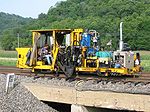 A Spiker part of a fleet of Maintenance of way vehicles
A Spiker part of a fleet of Maintenance of way vehicles
Contents: Top · 0–9 · A B C D E F G H I J K L M N O P Q R S T U V W X Y Z N
Definitions Points of Interest - Narrow gauge: Railroad track where the rails are spaced less than 1,435 mm (4 ft 8 1⁄2 in) apart.[50] There are many common gauges narrower than standard, amongst them 3 ft 6 in (1,067 mm) widely in Africa and Asia; 3 ft (914 mm), which was the most common narrow gauge in the U.S.; 2 ft 6 in (762 mm), used in various locations across Europe, Asia and elsewhwere, South America and Australia, and 2 ft (610 mm), which saw widespread use in the UK. Meter gauge 1,000 mm (3 ft 3 3⁄8 in) is also widely used in Asia and Africa. Narrow-gauge lines are often found in mountainous terrain where the cost savings of building a smaller railroad can be considerable. (Historically, the term "narrow gauge" was once used in Britain for what is now called standard gauge, as the only other gauge then in common use was the Great Western Railway's 7 ft 0 1⁄4 in (2,140 mm) broad gauge.)
- Northern: A steam locomotive with a 4-8-4 wheel arrangement. Also known variously in North America as "Pocono", "Niagara", "Confederation", "Greenbrier", et al. (see Whyte notation).
- Notch 8: The 8th Notch of the throttle control, indicating Full Power.
Contents: Top · 0–9 · A B C D E F G H I J K L M N O P Q R S T U V W X Y Z O
Definitions Points of Interest - Open wagon (UIC, UK), Gondola (US). A form of freight hauling car for bulk goods.[51]
- ORER Official Railway Equipment Register.[52]
- Overbridge (UK): A bridge over the railway.
- Overlap (UK): A distance (normally 180 metres or set according to the permitted speed of the line) beyond a stop signal which must be clear before the preceding stop signal can display a proceed aspect; allows a margin in case a train overshoots a signal before stopping.
 Open wagon Gondola style freight car
Open wagon Gondola style freight car
Contents: Top · 0–9 · A B C D E F G H I J K L M N O P Q R S T U V W X Y Z P
Definitions Points of Interest - P-train: An NMBS/SNCB commuter train.
- Pacific: A steam locomotive with a 4-6-2 wheel arrangement.
- Pannier tank: A tank locomotive with the water tanks mounted on the boiler like panniers.
- Pantograph: An arm to pick up current from overhead lines.[53]
- Paper: Colloquially, a track warrant, train order or other movement permit that is dictated by a dispatcher and copied in writing by a train crew member.
- Per diem: A fee paid by a rail company to the owner of a car (US) (wagon (UK)) for the time it spends on the company's property; also an authorized living expense payment for some workers forced away from their home terminal. Pronounced by some U.S. railroaders per die-um, not per dee-um.[53]
- Permissive signal: a block signal whose most restrictive indication is stop and proceed. A permissive signal is identified by the presence of a number plate affixed to the mast or supporting structure. Proceeding beyond a permissive signal at stop is allowed at restricted speed if operating conditions enable a train operator to stop before reaching any train or obstruction.
- PICOP (UK): Person In Charge Of Possession – the railway or contractor's official responsible for safe working during engineer's possession.
- Pilot engine (UK): The leading locomotive during a double heading operation, attached in front of the train engine.
- Piston: The moving component in the cylinder of a steam engine or internal combustion engine that translates into motion the force exerted by pressurised steam or exploding fuel.[54]
- Point machine (UK): A motor or device which operates points.
- Points (UK): switch (US). Also "turnout".
- Pony truck: A two-wheel truck (US) or bogie (UK) at the front of a locomotive.[55]
- Porter: A Porter had various roles: A Baggage Porter assisted with luggage; an Operating Porter assisted with Safeworking duties; a Station Porter assisted with general station duties and a Lad Porter was a junior Station Porter.
- Position light signal: A block signal in which the position of the lights determine the meaning of the aspect shown.
- Pound (rail): Term describing the weight (and thus the cross section) of a length of rail. A heavier rail can carry heavier loads with less distortion and less damage to the rails themselves and the roadbed.
- Power: A slang term referring to a locomotive or group of connected (MU'd) locomotives serving as the motive power for a train (as in "the hostler brought the power to the service pit.")[53]
- Prairie: A steam locomotive with a 2-6-2 wheel arrangement.
- Pull-apart: A rail broken from cold-related contraction.
- Push pole: Push pole about 12 feet (366 cm) long and having a diameter of 5 inches (127 mm). They were placed in receptacles called push pole pockets. The pole was placed between the locomotive and the freight car, and used to push the car on or off a siding or to another track. Used between 1870 and the mid 1960s.[56]
- Push-pull: A mode of operation whereby a locomotive-hauled train may be driven with the locomotive at the front, middle or back of the train. Also: Auto train (UK), above. See Top and tail for train with locomotives at both front and back.[53]
Contents: Top · 0–9 · A B C D E F G H I J K L M N O P Q R S T U V W X Y Z Q
Definitions Points of Interest Contents: Top · 0–9 · A B C D E F G H I J K L M N O P Q R S T U V W X Y Z R
Definitions Points of Interest - Railbus: A passenger rail vehicle (typically non-articulated or rigid frame) that was derived from bus propulsion and construction technology, but which may evolve into larger dimensions, performance and characteristics similar in appearance to a light DMU Railcar
- Railcar: A powered single unit or articulated passenger car, usually “railroad-derived” light DMU or EMU, with a driver's cab at one or both ends.
- Railfan: A hobbyist or enthusiast of trains (q.v. "Foamer").
- Rail grinder: a machine used to remove irregularities in the surface of the rails. May be self powered or part of a consist.
- Rail profile The cross section shape of rail. There are many rail profiles which are often specific to individual railroads. Rails need to be periodically scanned electronically, the data inspected and analysed, then re-profiled with rail grinding machines to maintain the safe and proper "rail profile". Rails that cannot be brought back to the proper rail profile are condemned and replaced.
- Railroad car: A railroad vehicle that is not a locomotive.
- Railroadiana: Artefacts of railways around the world.
- Rail sled (US): A form of wheel chock that slips onto the rail under the wheel of rolling stock which prevents the vehicle from rolling.
- Rail Tractor: A small petrol (gas) or diesel shunting (switcher) locomotive.
- Railway line may refer to:
- A railway route connecting two or more places or other railway routes.
- A railway route constructed by an organization, usually one formed for that purpose.
- A railway route which has been given the line name officially (e.g. by ELRs in the UK).
- A set of railway routes which are bundled for publicity purposes by, e.g., a UK TOC.
- A set of railway routes without official standing, on which railfans have bestowed a title.
- Railway station : A train station.
- Rake: (UK) A group of passenger coaches coupled together.
- Red: A colour generally associated with stop, when shown by signals or flags.
- Reefer: A refrigerated railcar, used to transport perishable goods.
- Rent-a-Wreck (slang, U.S.): A (usually old) locomotive owned by a leasing company.[57]
- Reporting mark: A two- to four-letter code, assigned by the Association of American Railroads, that is applied to equipment operating on North American railroads to identify the owner.[58]
- Rerail frog or rerailer a metal casting slotted over the rail near the wheel of a derailed train car. The engine then pushes or pulls the car so that the derailed wheel runs up the rerailer and back onto the track.
- Reverser or Reverser handle: the handle that controls the directional control on a locomotive (see also Cut off, above).
- Restricted speed (US): A speed not exceeding 20 mph which allows stopping within half the range of vision short of an obstruction on the tracks.
- Retarder: A device installed in a classification yard used to reduce the speed of freight cars as they are sorted into trains.[59]
- Ribbon Rail: Continuously welded rail.[58]
- Right-side failure: A failure in a signalling or other safety critical system which leaves the system in a safe condition.
- RoadRailer: A highway trailer, or semi-trailer, that is specially equipped for direct use on a railroad.
- Roll-by: (US; also "Rollby") Visual inspection of a passing train by personnel on the ground for defects or dragging equipment.
- Rolling stock: (UK) A railway vehicle that is not a locomotive; 'railway car'. (US) Any railroad car and/or locomotive.[58]
- Rookie: See Trainee.
- Run-round (runaround (US)): the practice of detaching a locomotive from its train, driving it to the other end of the train and re-attaching it, to allow the train to proceed in the direction it has just come from (e.g. when it reaches its destination and forms a service in the other direction).
(See headshunt for diagram of a 'run-round loop'.)[58]
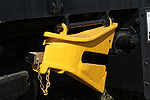 Rerail Frog or rerailer at the Saskatchewan Railway Museum
Rerail Frog or rerailer at the Saskatchewan Railway Museum
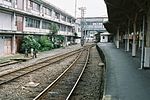 Platform track and run-round loop at Toyooka Station, Hyōgo, Japan, the terminus of the line from Miyazu
Platform track and run-round loop at Toyooka Station, Hyōgo, Japan, the terminus of the line from Miyazu
Contents: Top · 0–9 · A B C D E F G H I J K L M N O P Q R S T U V W X Y Z S
Definitions Points of Interest - Saddle tank: A tank locomotive with the water tank mounted on top of the boiler like a saddle.[60]
- Safety Appliance Act (US): A law mandating air brakes, grab bars, and automatic couplers
- Safeworking: The system of rules and equipment designed to ensure the safe operation of trains.
- Sand: granular material poured on the rail in front of the drive wheels to improve traction. (Sandite is a more specialised form for a similar purpose.)
- Sandbox: A container on locomotives and self-propelled multiple units, or trams, that run on tramways and adhesion railways. The container holds sand which can be dropped on to the rail to improve rail adhesion under wet, steep or slippery rail conditions. The sandbox and operating mechanism are collectively known as 'sanding gear'.
- Sandite: consists of a mixture of sand, aluminium and a unique type of adhesive, used instead of plain sand for extreme slippery rail conditions.
- Santa Fe type: A steam locomotive with a 2-10-2 wheel arrangement, named for the Atchison, Topeka and Santa Fe Railway, the first railroad to use such a configuration.
- Schnabel car: A specialized type of freight car for extra heavy and over sized loads; the car is loaded in such a way that the load forms part of the car superstructure.
- Searchlight: A signal with a single light source usually capable of displaying three different colors. An internal mechanism governs the color displayed.[60]
- Section: The division of the track for security (occupation).
- Semaphore: A type of signal that has a moving arm; any signalling using semaphores.
- Shay: A type of geared steam locomotive built to the patents of Ephraim Shay.[60]
- Shoofly (US): A temporary stretch of track that takes trains around construction or an accident scene.[60]
- Shunt (UK) (AUS): To move trains or vehicles from one track to another.
- Shunt (US): To bond the rails/power feeds between sections on trolley/light rail systems, so as to temporarily bridge past dead areas.
- Shunter (UK): switcher (US) or shifter (PRR only): A small locomotive used for assembling trains and moving railroad cars around. Also, a person involved in such work.[60]
- Shuttle service: A train, usually a passenger service, that runs back and forth over a relatively short distance, such as between a junction station and a branch-line terminus.
- Side tank: A tank locomotive with water tanks mounted each side of the boiler.
- Siding: A section of track off the main line. Sidings are often used for storing rolling stock or freight. A siding is also used as a form of rail access for warehouses and other businesses, where the siding will often meet up with loading docks at rail car height in the building. In the U.S. the term is also used to cover the British term: loop. Also, a passing track in the U.S.
- Signal: A device that indicates to the driver of a train information about the line ahead.
- Signal aspect: The information conveyed to a railroad vehicle operator by a block signal. Signals may use colored lights, position-significant lights or mechanical semaphores to generate various aspects.
- Signal box: A building or room which houses signal levers (usually in a frame), a control panel or a VDU-based control system.
- Signal Passed At Danger or SPAD (UK): where a train disobeys a stop signal.
- Signalman: A person in charge of the signalling at a station or junction, often in a Signal-box.
- Six-foot: The narrow corridor between a pair of closely spaced tracks, nominally six feet wide. See also four-foot and ten-foot.
- Slack (UK): A temporary speed restriction to protect, for example, sections of track in poor condition and awaiting repair. Also applies to the timing tolerance included in timetable schedules to allow for such restrictions.
- Slack action (UK/US): Looseness in a train caused by mating clearances in couplers.[60]
- Sleeper (UK), tie (US): Bars placed at 90° to the rail tracks to support the rails. Generally of wood, concrete or steel, with hardware to affix the rails, usually spikes, nails or bolts. Note in the UK baseplates and clips are used to affix the rail to the sleeper. Spikes are widely used in North America.
- Slippery rail: The condition of fallen leaves or other debris lying on and clinging to a railroad track that could cause train wheel slippage, resulting in premature wheel wear and train delays.
- Slow order: A local speed restriction below the track's normal speed limit often designated by yellow and green flags. Slow orders can be imposed on a temporary basis to protect, for example, maintenance of way employees while sections of track are under repair. Widely used in areas where track is substandard and in need of repair.
- Slug: A locomotive that contains traction motors yet lacks the diesel engine to create its own power, which is instead supplied by a connected 'mother' locomotive.[60]
- Smokebox: An enclosed (normally cylindrical) space attached to the end of the boiler opposite the firebox on a steam locomotive (normally the front). Supports the stack/chimney; steam pipes to and from the cylinders pass through here; contains the blastpipe/exhaust nozzle where the exhaust steam is used to provide draft for the fire. In superheated locomotives, also contains the superheater header and (optionally) a front-end throttle. A smokebox door allows access for cleaning.
- Smokestack (abbr. stack) (US): chimney (UK).[61]
- Snow plough (Snowplow) or rail snow plough is a rail service vehicle used for snow removal from train tracks.[62][63]
- SPAD (UK): Signal Passed At Danger, where a train disobeys a stop signal. Sometimes referred to as a "blown red" in U.S. railroad slang.
- Speeder (US): A small vehicle used to let track inspectors and work crews move quickly to and from work sites. (Obsolete) Speeders have mostly been replaced by trucks and SUVs with retractable flanged wheels.[64]
- Spike: A bolt, pin or nail used to hold rails, or plates connected to the rails (known as tie plates), to sleepers (ties). Commonly called a "Dog" or "Dogspike" in Australia.
- Spiral easement See Track transition curve. Also known as tangent lead-in.[60]
- Spreader a maintenance of way equipment designed to spread or shape ballast profiles, remove snow, clean and dig ditches as well as trim embankments
- SPT (UK): Signal-post telephone - A direct no-dial telephone link to the relevant Signal-box, positioned on or near a signal.
- Spur (US): A stretch of rail that branches off the main line. Different from a siding or stub, spurs can be miles in length, and usually have only one destination at the end.[60]
- SPURT (India): An acronym for Self Propelled Ultrasonic Rail Testing, a self-propelled rail defect detector car.[65]
- Staff and ticket: A method of safeworking involving a token.[60]
- Standard gauge: Railroad track where the rails are spaced 1,435 mm (4 ft 8 1⁄2 in) apart. This is by far the most common gauge of railway worldwide.[60]
- Station-master: The person in charge of a station.
- Station pilot (UK): Shunting engine based at a major passenger station and used for passenger train shunting duties.
- Steam generator: A device generally used in passenger trains to create steam for heating. The steam generator is usually in the locomotive but may also be located in other cars.[60]
- Steam reverser: A Cut Off worked by a steam piston controlled from the cab.
- Steeplecab (US): An electric locomotive with a central cab and sloping "noses" on each end.
- Steward: A person in a dining car with a role similar to that of a Maitre d’Hotel.
- Stub (North America) A relatively short section of track that ends at a bumper or wheelstop, most often found in a terminal. Not to be confused with a spur, which may be miles (kilometers) in length.
- Subway (UK): A tunnel passing underneath the railway tracks to allow passengers to cross from one platform to another.
- Subway (US): A railroad that runs underground, generally in a large city. Subways are also considered "heavy rail" because they operate on their own dedicated track. Not to be confused with the interurban definition of subway, which is normally a light-rail passenger service running mostly underground.
- Supercharger A mechanical device that boosts the pressure of engine intake air to above atmospheric level, causing an increase in power. Not to be confused with the blower used to scavenge the cylinders of a naturally aspirated two-stroke Diesel engine.
- Superelevation (UK): Synonymous with cant: the banking of railroad track on curves. Specifically, the practice on high speed lines (where the cant needs to be higher) of gently introducing the elevation of the outer rail before the bend starts, in order to avoid sudden lurches.[60]
- Superheater: A device in a steam locomotive that raises the temperature of saturated steam substantially beyond the boiling point of water, increasing power and efficiency.[60]
- Switch (US): points (UK). Also "turnout".[60]
- Switcher (US), shunter (UK): A small locomotive used for assembling trains and moving railroad cars around.[60]
- Switchman: A railroad worker responsible for assembling trains and switching railroad cars in a yard; now often used together with brakeman as a single job description ("brakeman/switchman").
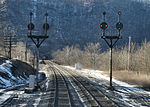 Two-head color position signal on CSXT mainline near Magnolia, West Virginia. The left head displays "Stop", the right head, "Clear".
Two-head color position signal on CSXT mainline near Magnolia, West Virginia. The left head displays "Stop", the right head, "Clear".
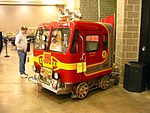 A privately owned speeder on display at the Mad City Model Railroad Show and Sale in Madison, Wisconsin, February 2004
A privately owned speeder on display at the Mad City Model Railroad Show and Sale in Madison, Wisconsin, February 2004 Two unused and one heavily corroded spikes. The measurement scale shown is inches.
Two unused and one heavily corroded spikes. The measurement scale shown is inches.
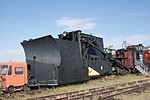 Jordan Spreader
Jordan Spreader
 A pair of EMD SW900 switchers
A pair of EMD SW900 switchers
Contents: Top · 0–9 · A B C D E F G H I J K L M N O P Q R S T U V W X Y Z T
Definitions Points of Interest - Tank car: A type of rolling stock designed to transport liquid and gaseous commodities.
- Tank engine (UK): A locomotive that carries its own fuel and water instead of hauling a tender. The fuel is usually in a bunker behind the cab and the water in tanks on either side of, above, or below the boiler (respectively: side tank, saddle tank, well tank).
- Team track: A spur or siding for loading freight, often used by firms not having their own direct rail access.[66]
- Ten-foot: An area, usually at least ten feet wide, between a pair of widely spaced tracks, wide enough to form a place of safety in which railway workers can stand while a train goes past. See also four-foot and six-foot.
- Ten-wheeler (US): A steam locomotive with a 4-6-0 wheel arrangement.
- Terminal station (esp. U.S.), terminus (esp. UK): A station sited where a railway line or service ends or terminates.
- Terminal railroad (or terminal railway) is company in the United States that owns no cars of its own and transports only the railroad cars of other companies around a specific terminal station.[67]
- Texas type: A steam locomotive with a 2-10-4 wheel arrangement.
- The T (US): A nickname for Massachusetts Bay Transportation Authority (MBTA) the Subway service through Boston, Massachusetts.
- Theatre indicator (UK) An illuminated number usually attached to signal indicating arrival platform for train approaching a station.
- Third Rail: An electrified rail that runs along the tracks, giving power to trains. Used mostly in subways and rapid transit systems.[66]
- Through platform: The standard platform and track arrangement at a station. The train pulls alongside the platform, arriving from one end of the station, and may pass out the other end of the station by continuing along the same track.
- Through-routing: Combining two or more different railways onto a common length of track. This is often done to eliminate redundant trackage and/or improve service.
- Tie (US): sleeper (UK): A rectangular object used as a base for railroad tracks.[66]
- Tram: A city-based rail system that typically shares its operational space with other vehicles and often runs on, across or down the center of city streets.
- Tram-train are trams that are designed to run both on the tracks of a city-based rail system and on the existing railway networks. Tram-trains dual-voltage capability makes it possible to operate at lower speeds on city streets and at over 60 mph (100 km/h) on main line tracks allowing travel in an extended geographical area without changing the method of transport.
- Tie plate: A plate which is bolted to sleepers, holding the rails in place.
- Timetable direction: The general compass direction of a railroad or subdivision, as specified by its official timetable (rulebook). Only north, south, east or west may be specified (i.e. northeast, southwest, east-southeast, etc. are excluded).
- TOFC: An abbreviation for "Trailer-On-Flat-Car" (Intermodal freight transport).[66]
- Token: A physical object given to a locomotive driver to authorize him to use a particular stretch of single track.
- Top and tail (UK): A train with locomotives at both ends, for ease of changing direction.
- Torpedo (US): A small explosive device strapped to the top of the rail to alert an approaching train of danger ahead. A torpedo creates a loud noise upon contact with a locomotive wheel, signaling the engineer to reduce speed to 20 mph or less; the train cannot resume its original speed until it has traveled at least a mile beyond where it encountered the device. Traditionally used in pairs to ensure that the sound registered with train crews, torpedoes today are essentially obsolete as modern locomotive cabs' soundproof construction renders the devices useless. (UK:Detonator)[66]
- Torpedo tube: A slang term for a type of roof-mounted air reservoir. The long, cylindrical tanks (which resembled the torpedo launch tubes on World War II PT boats) were integral to the design of the EMD SD24, and retrofitted (both at the factory and on an aftermarket basis) to other locomotives such as the GP7, GP9, and CF7 (typically when the units were placed into passenger train service and larger fuel and water storage tanks were required).
- Trackage rights (US): The legal right of one railroad company to use the tracks of another, as agreed to by the companies concerned or their predecessors; may also be ordered by government regulators, for example, as a condition of a merger. Running powers (UK).[66]
- Track bed or trackbed: the foundation of rail tracks
- Track circuit: An electrical circuit that detects the presence or absence of locomotives and/or cars in a section of track, the section referred to as a block. Track circuits provide real-time inputs to signaling logic.
- Trackside objects: See Wayobjects under "W" below.
- Track bulletin: A form used by railroad employees that shows the locations of slow orders, maintenance of way work locations, and other conditions affecting the track and movement of trains.
- Track tamping machine: Generally, a locomotive used in track maintenance and equipped with track lifting facilities, and paddles enabling ballast to be pushed beneath a rail track so as to assure its level and cant.
- Track transition curve: The gradual application of superelevation and tighter curve radius, calculated with reference to the anticipated line speed and the final curve radius, on the approach to a bend. Also known as the transition spiral and spiral easement.
- Track warrant (TWC) (US) Occupancy Control System (OCS) (CA): A system for authorizing main track occupancy using defined points such as mileposts, switches, or stations.[66]
- Traction motor: A large electric motor that powers the driving wheels of an electric or Diesel-electric locomotive.[66]
- Traction supply: The supply for the driving traction motors of electric trains.
- Tractive effort: the pulling or pushing force exerted by a locomotive or other vehicle.
- Trailing: A turnout is trailing if the two legs of that turnout merge in the direction of travel. See Facing.
- Trainee: An employee who is new on the job and has completed railroad school.
- Train engine (UK): The locomotive closest to the train during a double-heading operation.
- Trainman: An employee assigned to train service, such as a Conductor, Brakeman or Switchman.
- Trainmaster: A Dispatcher, the person(s) in charge of all traffic within the assigned blocks.
- Train order: A system for authorizing main track occupancy using telephone, telegraph and wayside stations to pass authority to train crews.
- Train register (UK): A book or loose-leaf sheets kept in a signal box and used to record the passage of trains, messages passed, and other prescribed events.
- Trainset: A group of rolling stock that is permanently or semi-permanently coupled together to form a unified set of equipment. Trainsets are most often used in passenger train configurations.
- Treadle: A mechanical or electrical device for detecting the presence of a rail vehicle with pin-point accuracy, unlike a track circuit, which provides detection over an arbitrary distances.
- Triangle (UK), Wye (US): A track layout that facilitates the turning of engines or complete trains.
- Truck (mainly US and Canada as well as Mexico) See Bogie
- Truck (UK, outdated/informal): freight car.
- Turnout: A switch (also known as a set of points)
- Turntable: A section of track that can rotate, allowing locomotives and rolling stock to be reversed, and also allow a large number of engine maintenance sidings to be accessed in a small area.
 A track tamping machine in the sidings at Chester railway station
A track tamping machine in the sidings at Chester railway station
Contents: Top · 0–9 · A B C D E F G H I J K L M N O P Q R S T U V W X Y Z U
Definitions Points of Interest - Underbridge (UK): A bridge carrying the railway and allowing a roadway (etc.) to pass under the railway.
- Union station or union terminal (US), joint station (UK): A railway station (q.v.) at which tracks and facilities are shared by two or more railway companies.[68]
- Up (UK, etc.): A direction (usually towards London, other capital city, or the headquarters of the railway concerned) or side (on left-running railways, the left side when facing in the up direction). The opposite of down. The up direction is usually associated with even-numbered trains and signals.
- UP (US): The common name and reporting mark for the Union Pacific Railroad.
 The main concourse building and facade of Cincinnati Union Terminal
The main concourse building and facade of Cincinnati Union Terminal
Contents: Top · 0–9 · A B C D E F G H I J K L M N O P Q R S T U V W X Y Z V
Definitions Points of Interest - Vacuum brake A continuous train brake which is fail-safe in operation: the brake is powered by a vacuum from the locomotive but the application is actually by atmospheric pressure when the vacuum is released. Now largely superseded by the air brake.
- (goods) Van (UK), boxcar (US): An enclosed railroad car, or piece of rolling stock, used to transport freight.
- Van (CA): Eastern Canadian word for caboose.
Contents: Top · 0–9 · A B C D E F G H I J K L M N O P Q R S T U V W X Y Z W
Definitions Points of Interest - Water glass/gauge: A device showing the level of water in the boiler.[69]
- Way car: A term used by the Chicago, Burlington and Quincy Railroad, Chicago and North Western Railway and Atchison, Topeka and Santa Fe Railway instead of caboose.[69]
- Wayobjects or Wayside objects: Trackside objects are any structures at the wayside or beside the rail tracks usually within the right-of-way, such as:
-
- railway signals
- third rails
- overhead lines and their supports
- electrification systems
- platforms
- boom barriers
- Wayside: Trackside. The term presumably has its origin from the term right-of-way.
- Well tank: A type of tank locomotive. The water tank is mounted between the frame plates, beneath the cab and boiler.
- Well wagon: A flat wagon that has a depressed centre and is used for carrying extra tall loads.
- Wheel: The rolling component typically pressed onto an axle and mounted on a rail car or locomotive truck or bogie. Wheels are cast or forged (wrought) and are heat treated to have a specific hardness. New wheels are trued to a specific profile before being pressed onto an axle. All wheel profiles need to be periodically monitored to insure proper wheel to rail interface. Improperly trued wheels increase rolling resistance, reduce energy efficiency and may create unsafe operation. A railroad wheel typically consists of two main parts: the wheel itself, and the tire around the outside. A rail tire is itself steel, and is typically heated and pressed onto the wheel, where it remains firmly as it shrinks and cools.
- Wheel Climb: The process of a wheel climbing up and often off the inside or gauge side of the rail. It is a major source of derailments. Wheel climb is more likely to occur in curves with wheels whose flanges are worn or have improper angles. See Rail adhesion.
- Wheel Flange: The inner section of a wheel that rides between the two rails. The angle between the wheel tread and flange is often specific to the rail to prevent wheel climb and possible derailments. See Rail adhesion. The wheel flange is part of the wheel tire.
- Wheel slip: The loss of traction due to a slippery rail or wheel. Wheel slip was common with steam engines as they started to move due to the excessive torque often generated at low speed. Steam engines carried sand dispensing gear to increase traction at the start of motion.[69]
- Wheel Tapper: An historical railway occupation; people employed to tap train wheels with hammers and listen to the sound made to determine the integrity of the wheel; cracked wheels, like cracked bells, do not sound the same as their intact counterparts. The job was associated with the steam age, but they still operate in some eastern European countries. Modern planned maintenance procedures have mostly obviated the need for the wheel-tapper.
- Wheel Tread: The slightly conical section (often with a 1 in 20 slope) of a railroad wheel that is the primary contact point with the rail. See Rail adhesion.
- Whistle: Train whistles are used as a safety warning and also by the engineer to communicate to other railroad workers. See train whistle for a description of the whistle code used to communicate. Also a nickname for an air horn on a diesel locomotive. Steam engine whistles were historically known as chimes in the US during the 19th century.
- Whistle post: An advanced warning to the engineer of an upcoming grade crossing. It is the point at which the engineer should begin sounding the whistle or horn.
- Whyte notation: A system of describing steam locomotive wheel arrangements, e.g. 4-6-4, 2-10-2. The first number indicates the number of "pilot" wheels that help lead the engine into turns. The second is the number of coupled wheels ("drivers"). Third are the trailing idler wheels, usually to provide support to larger fireboxes. Articulated locomotives are similarly described. For example, a Union Pacific "Big Boy" would be described as a 4-8-8-4, wherein the pilot has four wheels, followed by two sets of drivers, 8 wheels per set, and a 4 wheel trailing bogie under the firebox. The numbers include the wheels on both sides of the engine, so a 2-8-2 engine would have one idler, four drivers, and a final idler on each side of the engine.
- Wigwag: A Level or Grade Crossing Warning Signal consisting of a swinging disc facing road traffic with a red light in the centre. The disc normally hangs straight down, but an approaching train will set it swinging from side to side, the red light will illuminate or flash and a bell will ring.
- Wrong-side failure: A failure in a signalling system that leaves the system in a dangerous condition.
- Wye (US), triangle (UK): Three railroad tracks in a triangular form with switches at all three corners. With sufficient lengths of track leading away in all three directions, a wye can turn a train of any length.[69]
Contents: Top · 0–9 · A B C D E F G H I J K L M N O P Q R S T U V W X Y Z X
Definitions Points of Interest - X-ing (AU): Slang for road crossing or level crossing.[citation needed] Crossing (US).
Contents: Top · 0–9 · A B C D E F G H I J K L M N O P Q R S T U V W X Y Z Y
Definitions Points of Interest - Yard: A location where rolling stock is switched to and from trains, freight is loaded or unloaded, and consist made up. Also freight yard; classification yard or hump yard (types of freight yards); and coach yard (for passenger cars).[70]
- Yardmaster: The person(s) responsible for conducting all traffic within the yard. The Yardmaster gives orders for which cars go where in order to assemble or disassemble a consist.
- Yellow: A colour associated with a warning or a need to slow down when used by flags or signals; the exact meaning varies from railway system to railway.
- Yellowstone: A steam locomotive with a 2-8-8-4 wheel arrangement.
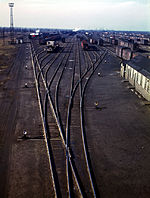 A railroad yard in Chicago, Illinois, (Proviso Yard) operated by the Chicago and North Western Railway as seen in December 1942
A railroad yard in Chicago, Illinois, (Proviso Yard) operated by the Chicago and North Western Railway as seen in December 1942
Contents: Top · 0–9 · A B C D E F G H I J K L M N O P Q R S T U V W X Y Z Z
Definitions Points of Interest - Zig zag, (U.S. commonly) switchback: a way of climbing hills, where the train reverses direction for a while, and then reverses again to continue its journey.
Contents: Top · 0–9 · A B C D E F G H I J K L M N O P Q R S T U V W X Y Z See also
- List of US railfan jargon
- List of UK railfan jargon
- List of NZ railfan jargon
- Transmodel CEN standard for Public Transport Information concepts and terminology
- Passenger rail terminology
References
- White, John H., Jr. (1968). A History of the American Locomotive - Its Development: 1830-1880. New York: Dover Publications. ISBN 0-486-23818-0.
- ^ http://www.uic.org/spip.php?article1593 www.uic.org, Transport Thesaurus, 1995, accessed 20 May 2009
- ^ White (1968), p. 57.
- ^ a b c d e "Glossary Of Common Railroad Terms: A". Kalmbach Publishing. http://trains.com/trn/glossary/default.aspx?list=4&fl=a. Retrieved 2008-01-29.
- ^ White (1968), p. 46.
- ^ "US Railfan Jargon". NTRACKAGE Writes (New Mexico Rail Runners) (199): page 5. October 2006. Archived from the original on 28 February 2008. http://web.archive.org/web/20080228220551/http://www.nmrailrunners.org/NtrakageWrites/2006/Oct.pdf. Retrieved 2008-01-24.
- ^ Marre, Louis A. (1995). Diesel Locomotives: The First 50 Years. Waukesha, WI: Kalmbach Publishing Co.. ISBN 0-89024-258-5.
- ^ Pinkepank, Jerry A. (1973). The Second Diesel Spotter's Guide. Kalmbach Books.
- ^ a b c d e f g "Glossary Of Common Railroad Terms: B". Kalmbach Publishing. http://trains.com/trn/glossary/default.aspx?list=4&fl=b. Retrieved 2008-01-29.
- ^ White (1968).
- ^ a b c d e f g h i "Glossary Of Common Railroad Terms: C". Kalmbach Publishing. http://trains.com/trn/glossary/default.aspx?list=4&fl=c. Retrieved 2008-01-29.
- ^ British Railway Telegraphic Codewords – from booklet BR30064 (accessed 2009-02-12)
- ^ Russell, Benjamin (1999-11-30). "RE: EL/Chessie Pool power". http://www.railfan.net/lists/erielack-digest/199912/msg00163.html. Retrieved 2008-01-24.
- ^ "3 Bay ACF Covered Hopper - C&O #607190". Model Junction. http://www.modeljunction.info/estore/product_info.php?manufacturers_id=54&products_id=7673. Retrieved 2008-01-24.
- ^ White (1968), p 209-210.
- ^ Chapman, Robert L. (1986). New Dictionary of American Slang (3rd ed.). Harper & Row. pp. 83.
- ^ Irwin, Godfrey (ed.) (1931). "American Tramp and Underworld Slang". Hobo Terminology. London: Scholartis; republished by the Original Hobo Nickel Society. http://www.hobonickels.org/terms.htm.
- ^ McIntyre, Terry L. (1969). "The Language of Railroading". American Speech 44 (4): 243–62. doi:10.2307/454681.
- ^ a b White (1968), p 465-466.
- ^ White (1968), p 186-187.
- ^ Holloway, Keith (2006-06-13). "Failure to adhere to track warrant control rules caused collision". NTSB press release (National Transportation Safety Board). http://www.ntsb.gov/pressrel/2006/060613.htm. Retrieved 2009-05-29. "Non-signaled (dark) territory presents a unique problem for rail safety"
- ^ a b c d e f "Glossary Of Common Railroad Terms: D". Kalmbach Publishing. http://trains.com/trn/glossary/default.aspx?list=4&fl=d. Retrieved 2008-01-29.
- ^ "Grades and Curves". Trains. http://www.trains.com/trn/default.aspx?c=a&id=211.
- ^ "Locomotives running elephant style". Trainorders.com. http://www.trainorders.com/discussion/read.php?4,557093. Retrieved 2008-01-24.
- ^ a b "Glossary Of Common Railroad Terms: E". Kalmbach Publishing. http://trains.com/trn/glossary/default.aspx?list=4&fl=e. Retrieved 2008-01-29.
- ^ McGonigal, Robert S. (2006-05-01). "Understanding railroad reporting marks". Trains.com. Kalmbach Publishing. http://www.trains.com/trn/default.aspx?c=a&id=278. Retrieved 2007-09-17.
- ^ White (1968), p102-108.
- ^ a b c d e f g "Glossary Of Common Railroad Terms: F". Kalmbach Publishing. http://trains.com/trn/glossary/default.aspx?list=4&fl=f. Retrieved 2008-01-29.
- ^ (bonus feature interview) This Was Pacific Electric (Liner notes). Glendale, California: Sky City Productions.
- ^ Lustig, David (August 2006). "End-of-train devices keep on evolving in back". Trains 66 (8): p 18. ISSN 0041-0934.
- ^ a b c d "Glossary Of Common Railroad Terms: G". Kalmbach Publishing. http://trains.com/trn/glossary/default.aspx?list=4&fl=g. Retrieved 2008-01-29.
- ^ a b c d e f g h i "Glossary Of Common Railroad Terms: H". Kalmbach Publishing. http://trains.com/trn/glossary/default.aspx?list=4&fl=h. Retrieved 2008-01-29.
- ^ Webb, Brian (1982). The Deltic Locomotives of British Rail. Newton Abbot: David & Charles. p. 40. ISBN 0-7153-8110-5.
- ^ "Railway Terminology: H". Australian Model Railway Association Incorporated. http://www.amra.asn.au/terms.htm#h. Retrieved 2008-03-08.
- ^ "Dover Harbor". National Railway Historical Society, Washington D.C. Chapter, Inc.. http://www.doverharbor.com. Retrieved 2008-01-29.
- ^ "Railroad Slanguage Glossary". Railway Life (Buffalo, Rochester and Pittsburgh Railroad). 1931. http://www.railroad.net/articles/railfanning/slanguage/index.php. Retrieved 2008-01-25.
- ^ Petersen, Richard A. (2003-09-30). Hogger: From Fantasy to Fulfillment: a Locomotive Engineer Remembers. iUniverse. ISBN 0595659349.
- ^ "Hotbox". The Hotbox (North Central Region National Model Railroad Association). Archived from the original on 7 January 2008. http://web.archive.org/web/20080107111410/http://info.detnews.com/hotbox/index.cfm. Retrieved 2008-01-24.
- ^ US 4659043
- ^ a b c "Glossary Of Common Railroad Terms: I". Kalmbach Publishing. http://trains.com/trn/glossary/default.aspx?list=4&fl=i. Retrieved 2008-01-29.
- ^ a b c "Glossary Of Common Railroad Terms: J". Kalmbach Publishing. http://trains.com/trn/glossary/default.aspx?list=4&fl=j. Retrieved 2008-01-29.
- ^ Union Pacific Railroad. "Fun Facts". http://www.uprr.com/aboutup/funfacts/rrtalk/engine.shtml. Retrieved 2007-03-05.
- ^ CAR and LOCOMOTIVE CYCLOPEDIA (1970), DICTIONARY OF CAR AND LOCOMOTIVE TERMS, A SIMMONS-BOARDMAN PUBLICATION
- ^ a b "Glossary Of Common Railroad Terms: L". Kalmbach Publishing. http://trains.com/trn/glossary/default.aspx?list=4&fl=l. Retrieved 2008-08-26.
- ^ Light Rail Transit Association LRTA What is Light Rail? - Retrieved on 2009-07-06
- ^ a b c d e "Glossary Of Common Railroad Terms: M". Kalmbach Publishing. http://trains.com/trn/glossary/default.aspx?list=4&fl=m. Retrieved 2008-01-29.
- ^ Kohlin, Ron (2005-02-09). "Railroad and/or Railfan Slang". http://kohlin.com/rr/rr_slang2.htm. Retrieved 2008-01-24.
- ^ "You know you're an idiot railfan if". The Idiot Railfan. http://www.mswphoto.com/IdiotRailfan/you_know.html. Retrieved 2008-01-24.
- ^ White (1968), p 62-65.
- ^ Semmens, P.W.B.; Goldfinch, A.J. (2000). How steam locomotives really work. Oxford: Oxford University Press. pp. 177–185. ISBN 978-0-19-860782-3.
- ^ "Glossary Of Common Railroad Terms: N". Kalmbach Publishing. http://trains.com/trn/glossary/default.aspx?list=4&fl=n. Retrieved 2008-01-29.
- ^ "Glossary Of Common Railroad Terms: O". Kalmbach Publishing. http://trains.com/trn/glossary/default.aspx?list=4&fl=o. Retrieved 2008-01-29.
- ^ "ORER - What does ORER stand for? Acronyms and abbreviations by the Free Online Dictionary.". http://acronyms.thefreedictionary.com/ORER. Retrieved 2008-04-25.
- ^ a b c d "Glossary Of Common Railroad Terms: P". Kalmbach Publishing. http://trains.com/trn/glossary/default.aspx?list=4&fl=p. Retrieved 2008-01-29.
- ^ White (1968), p 207-208.
- ^ White (1968), p 174.
- ^ Special to The New York Times. (26 June 1920, Saturday). "1 KILLED, 20 HURT IN JERSEY WRECK; Freight Car Jumps Rails and Rips Sides of Passenger Cars at Stevens. FIRE FOLLOWS COLLISION Edward Lawrence of Bordentown, Brakeman, Crushed Between Freight Car and Coach." (PDF). http://query.nytimes.com/mem/archive-free/pdf?res=9B05E0D6133EE13ABC4E51DFB066838B639EDE. Retrieved 2008-10-05.
- ^ "History of this "Rent a Wreck"". Trainorders. 2006-09-13. http://www.trainorders.com/discussion/read.php?2,1239969. Retrieved 2008-01-25.
- ^ a b c d "Glossary Of Common Railroad Terms: R". Kalmbach Publishing. http://trains.com/trn/glossary/default.aspx?list=4&fl=r. Retrieved 2008-01-29.
- ^ "Safety at the Switches". Popular Science Monthly (New York: Popular Science Publishing Co.) 107 (4): 38. October 1925. http://books.google.com/books?id=0CcDAAAAMBAJ&lpg=PA38&dq=railroad%20retarder&pg=PA38#v=onepage&q=railroad%20retarder&f=false.
- ^ a b c d e f g h i j k l m n o p "Glossary Of Common Railroad Terms: S". Kalmbach Publishing. http://trains.com/trn/glossary/default.aspx?list=4&fl=s. Retrieved 2008-01-29.
- ^ White (1968), p 114-122.
- ^ "Canadian Railway Hall of Fame -". Rotary snow plow (2002). 2006. http://www.railfame.ca/sec_ind/technology/en_2002_RotarySnowPlow.asp. Retrieved 2008-10-03.
- ^ Dysgraphyk; Aitken (1 February 2008). "scot-rail.co.uk » Snow ploughs". http://www.scot-rail.co.uk/page/Snow+Ploughs. Retrieved 2008-10-03.
- ^ "FAQ's & Answers". NARCOA. http://www.narcoa.org/newsite/faq.htm. Retrieved 2008-01-25.
- ^ "ICF rolls out prototype cars to test rails". The Hindu Business Line (The Hindu Group). 2005-10-02. http://www.thehindubusinessline.com/2005/10/02/stories/2005100201710300.htm. Retrieved 2008-01-30.
- ^ a b c d e f g h "Glossary Of Common Railroad Terms: T". Kalmbach Publishing. http://trains.com/trn/glossary/default.aspx?list=4&fl=t. Retrieved 2008-01-29.
- ^ Judicial and statutory definitions of words and phrases. Second series West Publishing Company - St. Paul, Minnesota - 1914
- ^ "Glossary Of Common Railroad Terms: U". Kalmbach Publishing. http://trains.com/trn/glossary/default.aspx?list=4&fl=u. Retrieved 2008-01-29.
- ^ a b c d "Glossary Of Common Railroad Terms: W". Kalmbach Publishing. http://trains.com/trn/glossary/default.aspx?list=4&fl=w. Retrieved 2008-01-29.
- ^ "Glossary Of Common Railroad Terms: Y". Kalmbach Publishing. http://trains.com/trn/glossary/default.aspx?list=4&fl=y. Retrieved 2008-01-29.
External links
Categories:- Rail transport
- Rail infrastructure
- Rail technologies
- Rail transport operations
- Glossaries
Wikimedia Foundation. 2010.


